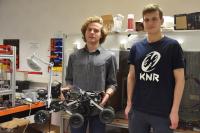Getting ready for 2019 University Rover Challenge according to Robotics Student Research Group

Damian Mucha (standing behind the rover) and Jacek Prokopczuk presenting their Mars rover prototype; photo: Office for Promotion and Information
The Warsaw University of Technology will be represented by as many as two teams in this year’s University Rover Challenge Finals, an international competition of student-built Mars rovers. The qualified teams both operate at the Faculty of Power and Aeronautical Engineering; these are the Robotics Student Research Group (“KNR”) and the Astronautic Student Research Group (“SKA”). We sat with Jacek Prokopczuk (KNR Leader) and Damian Mucha (Deputy Leader for Collaboration) to ask them about getting ready for the competition scheduled to run from May 30 to June 1.
What does it take a college student team to qualify for University Rover Challenge?
Jacek Prokopczuk: To enter the competition, we first have to prepare documentation where we provide the specification of our rover and describe the solutions applied. Some of the documents must be submitted already half a year in advance of the competition and the remainder is prepared a month before the big day. The rover is also assessed in a video we shoot to demonstrate its capabilities. Based on all these elements making up the System Acceptance Review(SAR), the judging panel decides whether we would make it to the finals.
Do you start working on a design and then adapt the existing idea to the competition requirements or, perhaps, build a dedicated model especially for the competition?
Damian Mucha: Our rover is designed specifically to perform the tasks asked of us at URC. Some of them require that we use, say, a manipulator to perform a mission or make repairs in a simulated Mars space station environment. Laboratories are specifically built for the competition as they are sort of a niche specialization and are created particularly for this occasion.
The upcoming event will not be your rover’s first.
J.P.: That is right. We competed with it back in 2018 and that was its first performance; rather poor as it was, it was a good lesson to learn and we figured out what needed to be improved. Now, the rover’s body has been practically all reworked; there is a new laboratory and a new manipulator; actually, the rover is three-fourths new.
Can you name the major parts of your HAL-062 rover?
J.P.: A rover has a rocker bogie suspension, which is also used in real-world rovers owing to its highest safety parameters and being ‘friendly’ for the overall structure. Then, there is the body housing all electronics and modules, i.e. a manipulator and an onboard laboratory (for the rover to test collected samples for extant life using appropriate chemical reagents) and an autonomy module, or a camera and a LIDAR, which help the rover avoid obstacles.
The competition venue, which is the Utah desert, is not a coincidence, is it?
J.P.: This is home of the Mars Society and the simulated space station. The competition is held at that location because it offers an environment that most closely resembles what it is like on Mars.
What will be your tasks during the competition?
J.P.: One of the tasks is to take and test samples, as mentioned before. There are also tasks involving machine vision, which means that we have to scout the desert for tennis balls using special area traversal algorithms. Of course, we cannot control the rover that the time; it reaches the designated spot autonomously and looks for what is known as a marker. If it finds a ball, it will produce an appropriate signal. The rover is self-driving and makes autonomous decisions what to do.
D.M.: Another task is to use the manipulator, e.g., to close a valve or to pull drawers.
Is there any task you feel the most comfortable about?
J.P.: We have a new manipulator and we hope it will prove its worth. Every task is a challenge so we take a holistic approach to our preparations.
What is the hardest and what is the best part of working on a rover?
J.P.: Obviously, it is great if everything works as it should. The design is a stumper in its own right. In theory, it may work all right, but when it comes to practice, suddenly, the parts do not fit together and you are back in square one. D.M. But putting the rover together is very exciting. That said, connecting the various modules tends to be tricky. We work on a team where different people do different things but, in the end, they all must be put together into one single and perfectly working whole.
You have arrived in the US a dozen or so days ahead of the event. What part of the preparations is scheduled for that time?
J.P.: Once we are at the venue, we reassemble the rover again and check how it works in the new setting. Factors such as the ambient temperature can affect its performance.
Do you try to take a peek at what other contenders are doing before the start?
J.P.: SAR is a good time for that. All teams have to submit their rover video demos and then you can have a look at some technical solutions but this is more of a check if others have outdone us on something or not. No dramatic changes are made because, by the time of making the SAR submission, all is already done and dusted.
What do you have that others do not?
J.P.: We have implemented an innovative solution: brushes to pile samples. Virtually all others use drills which are less efficient. Brushes did great in tests.
D.M.: We have skilled mechanics with great imagination. In terms of mechanics, a brush is a relatively simple solution, but it is likely to win on reliability.







